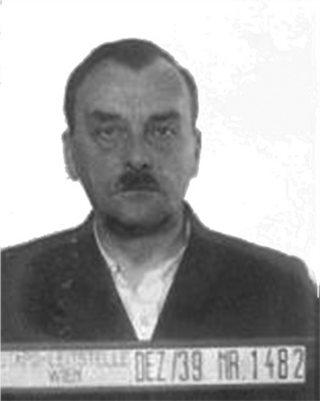DI Alfred Unger

Personalia
Born:
Died:
Profession:
Persecution:
Imprisonment 09.11.1939 - 22.04.1940, Dachau concentration camp 22.04.1940 - 25.08.1940, Neuengamme concentration camp 25.08.1940 - 14.09.1941, Dachau concentration camp 14.09.1941 - 02.05.1945
KZ Number:
Memberships
Curriculum Vitae
After graduating from high school, Alfred Unger first completed his one-year voluntary service and then studied engineering at the Technical University in Vienna. In 1913, he joins the student fraternity Franco-Bavaria. He took part in the First World War (1914-1918) - ultimately with the rank of first lieutenant - at the front in South Tyrol and was taken prisoner by the Italians.
He completed his technical studies with a degree in engineering and then went into the construction industry. He works as a deputy site manager on the construction of the Grossglockner High Alpine Road. He is involved in the founding of the Franco-Bavaria student fraternity Pflug.
After the Anschluss, Alfred Unger tries to keep the Franco-Bavaria student fraternity alive underground and to defend himself against National Socialism by founding his own resistance group. To this end, he organized secret meetings, which he later reported on:
"At our Seven meetings, each individual fraternity member was now discussed in detail with regard to reliability, fearlessness and safety in the event of arrest, and the fraternity brothers who were reliable in every respect were determined. Each of us seven had a few districts among us and were not allowed to disclose anything about the rest of us."
This group made contact with London and reported there.
On November 8, 1939, Johann Georg Elser (1903-1945) planned an assassination attempt on Adolf Hitler in Munich's Bürgerbräukeller, but failed to achieve his goal. The following day, Alfred Unger, his wife Hermine, their two children Trude and Herbert and five members of the group were arrested by the Gestapo in the police detention center and processed for identification on December 19, 1939. His wife was sentenced to three years in prison for high treason and treason against the country, his daughter was in Gestapo custody for five months and his son for three months
The protective custody order of January 20, 1940 states:
"According to the findings of the state police, his conduct endangers the existence and security of the people and the state, as he is strongly suspected of preparing high treason and is also suspected of being involved in the treasonous acts of a foreigner."
As all the arrested group members had kept their promises, nothing could be proven against them. They were released after several months in prison and drafted into the German Wehrmacht. Alfred Unger was transferred to the Dachau concentration camp as "Spitzenführer" on April 22, 1940 and from there to the Neuengamme concentration camp on August 25, 1940. Here he is severely abused and suffers considerable damage to his health as a result. On September 14, 1941, he was returned to Dachau concentration camp. "As a severe invalid", his daughter wrote, he was transferred back to Dachau, "where Chancellor Figl took care of him and got him off the gassing list!" The plan was to have him gassed in Hartheim. And in the Gestapo report of October 10, 1941, the following is recorded about Alfred Unger:
"The person named in the report was Dollfuß' 'bodyguard', in the closest CV association 'Franco-Bavaria' and belonged to Dollfuß' closest circle of friends. He was also arrested for his attitude in the course of an action against legitimists and reactionaries on November 9, 1939, as were his wife and daughter, and he is currently still in protective custody."
On the basis of this assessment, the defense office in military district XVII received the message "that the use of Alfred Unger as an officer d. B. was out of the question."
As the US Army approached Munich, Alfred Unger and a group of prisoners were sent on a march towards Tyrol. He was liberated on May 2, 1945 and returned to Vienna. He immediately returned to work for the city of Vienna, ultimately as a city planning officer.
Places
Persecution:
Residence:
Citations
Krause, Peter/Reinelt, Herbert/Schmitt, Helmut (2020): Farbe tragen, Farbe bekennen. Katholische Korporierte in Widerstand und Verfolgung. Teil 2. Kuhl, Manfred (ÖVfStG, Wien) S. 369/370.; Photo: ÖVfStg
